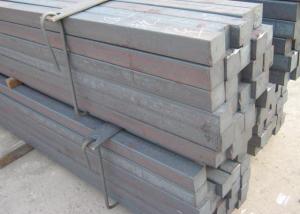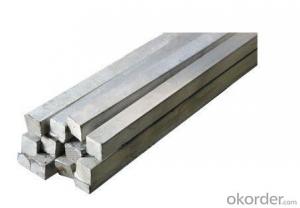Carbon Steel Hot Rolled Square Bar
- Loading Port:
- China Main Port
- Payment Terms:
- TT or LC
- Min Order Qty:
- -
- Supply Capability:
- -
OKorder Service Pledge
OKorder Financial Service
You Might Also Like
Product Description:
OKorder is offering Square Bar at great prices with worldwide shipping. Our supplier is a world-class manufacturer of steel, with our products utilized the world over. OKorder annually supplies products to European, North American and Asian markets. We provide quotations within 24 hours of receiving an inquiry and guarantee competitive prices.
Product Applications:
1. Chinese standard steel bar is often used where large amounts of steel need to be formed, for example as structural steel.
2. And we can use this kind of product on the performance of the mechanical parts if the demand is not very high.
3. Steel round bar is used in construction and a large number of architectural and engineering structures.
Product Advantages:
OKorder's Square Bar are durable, strong, and resist corrosion.
Main Product Features:
· Premium quality
· Prompt delivery & seaworthy packing (30 days after receiving deposit)
· Corrosion resistance
· Can be recycled and reused
· Mill test certification
· Professional Service
· Competitive pricing
Product Specifications:
1. Grade: Q195, Q235, Q345
2. Diameter: 6mm-150mm
3. Length: 6m, 9m, 12m or as customer’s request
4. Tolerance: Within ±5% for weight; ±2mm for diameter
5. Note: The price can be better is the quantity is good
6. Chemical composition
Alloy No | Element (%) | ||||
C | Mn | S | P | Si | |
Q195 | 0.06-0.12 | 0.25 | ≤0.05 | ≤0.045 | ≤0.3 |
Q235 | 0.12—0.20 | 0.3—0.7 | ≤0.045 | ≤0.045 | ≤0.3 |
Q345 | ≤0.2 | 1.00-1.60 | ≤0.045 | ≤0.045 | ≤0.55 |
Transportation:
-The products can be delivered by bulk vessel or by container. As for container, products with the length of 6m will be loaded in 20’ container, with 9m or 12m, in 40’ container.
-The maximum quantity of loading of container is 25 tons.
-The products usually are transported to the nearest port from the production place.
Payment:
-Invoicing on theoretical weight or actual weight a s customer’s request.
-FOB, CFR or CIF.
-Regular terms of payment:
1, 30% payment in advance, the remaining balance (70% payment) against the copy of B/L.
2, 30% payment in advance, the remaining balance (70% L/C) against the copy of B/L.
3, Negotiable.
FAQ:
Q1: Why buy Materials & Equipment from OKorder.com?
A1: All products offered byOKorder.com are carefully selected from China's most reliable manufacturing enterprises. Through its ISO certifications, OKorder.com adheres to the highest standards and a commitment to supply chain safety and customer satisfaction.
Q2: How do we guarantee the quality of our products?
A2: We have established an advanced quality management system which conducts strict quality tests at every step, from raw materials to the final product. At the same time, we provide extensive follow-up service assurances as required.
Q3: What makes stainless steel stainless?
A3: Stainless steel must contain at least 10.5 % chromium. It is this element that reacts with the oxygen in the air to form a complex chrome-oxide surface layer that is invisible but strong enough to prevent further oxygen from "staining" (rusting) the surface. Higher levels of chromium and the addition of other alloying elements such as nickel and molybdenum enhance this surface layer and improve the corrosion resistance of the stainless material.
Images:


- Q: Can a steel square be used for checking the alignment of a table saw fence?
- Yes, a steel square can be used for checking the alignment of a table saw fence. The straight edges of a steel square can be placed against the table saw fence and the table surface to ensure that they are parallel.
- Q: Can a steel square be used for checking the squareness of a fence post?
- Certainly, a fence post's squareness can be verified using a steel square. A steel square, which is also referred to as a framing square or carpenter's square, is a versatile tool extensively utilized in carpentry and construction projects to ascertain right angles and guarantee measurement accuracy. To check a fence post's squareness, one can position the steel square against the post to assess its perfect perpendicularity to the ground. Through aligning the square with the post and examining if the edges are flush against the post and the ground, any deviations from a right angle can be easily detected. Consequently, adjustments can be made to ensure proper alignment and upright positioning of the fence post, resulting in a straight and robust fence.
- Q: How much is the thick wall hollow square 30*30
- Steel is an important material for national construction and the realization of the four modernization indispensable, wide application, wide variety, according to the different steel profile is generally divided into sections and plates, pipes and metal products four categories, in order to facilitate the organization of steel production, supply and improve order management, and divided into heavy rail, light rail, large steel, and steel, small steel, steel cold-formed steel, high-quality steel, wire rod, steel plate, steel sheet, electrical silicon steel sheet, strip steel, seamless steel pipe, welded steel pipe, steel, metal products and other varieties.
- Q: Can a steel square be used for deck post layout and construction?
- Yes, a steel square can be used for deck post layout and construction. A steel square, also known as a framing square or carpenter's square, is a versatile tool that is commonly used by carpenters and builders for various layout and measurement tasks. It consists of a long arm and a shorter perpendicular arm, which are used to create right angles and ensure accurate measurements. When it comes to deck post layout and construction, a steel square can be used to ensure the proper alignment and positioning of the posts. It can be used to mark the correct angles and lengths for the posts, as well as to check for squareness and levelness during the construction process. Additionally, a steel square can also be handy for other deck construction tasks such as marking and cutting joists, checking for levelness and squareness of the deck frame, and verifying the alignment of railing posts. Overall, a steel square is a valuable tool for deck post layout and construction, providing accuracy and precision in ensuring that the posts are properly positioned and aligned.
- Q: Can a steel square be used for shed post layout and installation?
- Yes, a steel square can be used for shed post layout and installation. Steel squares, also known as framing squares or carpenter's squares, are versatile tools that can be used for various woodworking projects, including shed construction. They provide accurate measurements and angles, making them suitable for marking and aligning posts during layout and installation.
- Q: Can a steel square be used for tile work?
- Yes, a steel square can be used for tile work. It can be a useful tool for measuring and marking tiles accurately, ensuring precise cuts and angles.
- Q: Can a steel square be used for laying out a deck?
- Yes, a steel square can be used for laying out a deck. A steel square, also known as a framing square or carpenter's square, is a versatile tool that can be used in various construction and carpentry projects, including deck building. It is commonly used to lay out and mark right angles, measure and mark cuts, and check for squareness and levelness. When laying out a deck, a steel square can be used to ensure the accurate positioning and alignment of the deck framing and support structures. It can be used to mark the layout of the deck boards, determine the placement of posts and beams, and verify that the deck corners are square. The steel square typically has two arms - a long one called the blade and a shorter one called the tongue. The blade is usually 24 inches long and the tongue is 16 inches long. These measurements make it convenient for deck layout since standard deck boards are often 6 or 8 feet long. The steel square allows for precise measurements and angles to be marked, ensuring a professional and accurate deck layout. Overall, a steel square is a reliable tool for laying out a deck as it provides the necessary accuracy and precision required for a successful and visually appealing deck construction project.
- Q: Can a steel square be used for creating dado joints?
- Indeed, dado joints can be created using a steel square. A steel square proves to be a flexible and precise instrument that serves various woodworking purposes, among them the creation of dado joints. By employing the square, one can accurately delineate the appropriate width and depth of the dado joint, guaranteeing meticulous and precise cuts. Moreover, the square can be utilized to align the saw blade or router bit, ensuring the proper placement of the dado joint. All in all, a steel square proves to be an invaluable tool in the creation of dado joints, allowing for professional and meticulous outcomes to be achieved.
- Q: Can a steel square be used for door and window installation?
- Yes, a steel square can be used for door and window installation. Steel squares are commonly used in construction and carpentry for measuring and marking angles, ensuring accurate and precise installation.
- Q: How do you use a steel square to measure diagonals?
- To use a steel square to measure diagonals, simply place the square against the corner of the object or surface you want to measure. Align one edge of the square with one side of the object and make sure the other edge is perpendicular to it. Then, measure the diagonal by extending the other edge of the square until it reaches the opposite corner. The measurement you obtain is the length of the diagonal.
Send your message to us
Carbon Steel Hot Rolled Square Bar
- Loading Port:
- China Main Port
- Payment Terms:
- TT or LC
- Min Order Qty:
- -
- Supply Capability:
- -
OKorder Service Pledge
OKorder Financial Service
Similar products
Hot products
Hot Searches
Related keywords




























